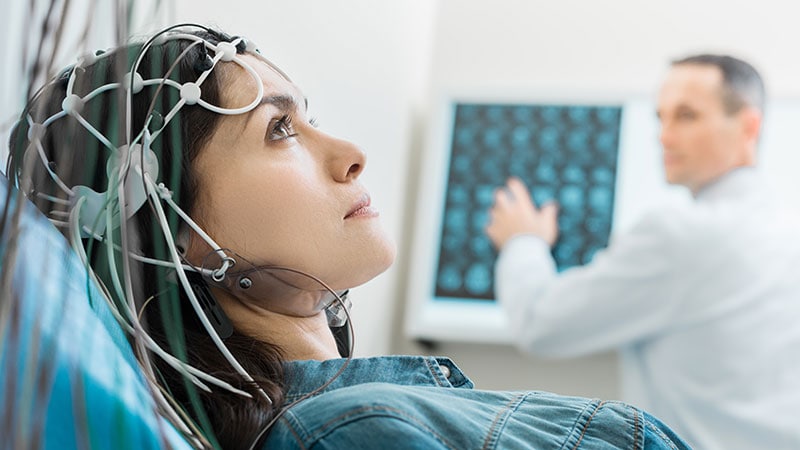Fentanyl depresses breathing about 4 minutes before symptoms of distress are evident at a dose that is 1700 times lower than that needed for sedation, new research shows.
This new information comes after researchers identified a unique EEG signature produced by fentanyl, the first known biomarker of an opiate’s effect on the brain.
By monitoring the EEG signal, investigators were able to monitor fentanyl concentration and respiratory depression. The discovery helps explain fentanyl’s lethality when used outside a clinical setting and could enable clinicians to better titrate opioids during and after surgery and in patients who are unconscious.
“Being able to precisely titrate opioids in the operating room context and in the intensive care context will be huge,” investigator Patrick Purdon, PhD, chair of anesthesia innovation and bioengineering at Massachusetts General Hospital and an associate professor of anesthesia at Harvard Medical School, told Medscape Medical News.
The findings were published online August 30 in PNAS Nexus .
Unique EEG Signature
Most anesthetic drugs have a distinct EEG signature that clinicians can use to track the drugs’ effects. But opioids had no known signature or biomarker of any kind.
Opioids are routinely administered to surgical patients to limit nociception from intubation, and fentanyl is one of the most widely used. For the study, 25 patients undergoing general anesthesia for surgeries lasting at least 2 hours received fentanyl administered gradually over a 4-minute period in doses of 2 μg/kg of ideal body weight every 2 minutes, with a maximum dose of 6 μg/kg of ideal body weight.
To track patients’ level of sedation and consciousness, each patient was asked to list to a series of noises through headphones and press the right or left button of a computer mouse to identify if the noise was a human voice or a clicking sound.
Researchers identified changes in theta oscillations that corresponded with patients’ respiration, sedation, and loss of consciousness. They were able to use this biomarker to measure fentanyl’s effects.
Postsurgical analysis of the EEG data and other information on respiratory function revealed that patients’ respiration began to slow long before their performance on the auditory task indicated signs of sedation.
They found that fentanyl is more than 1700-fold more potent for respiratory depression than for sedative effects, indicating that outside of a controlled medical environment, fentanyl would induce apnea well in advance of sedation or behavioral effects.
“This makes it clear that no amount of fentanyl is safe outside of a clinical setting,” Purdon said.
More Work Needed
Although the study only looked at fentanyl, Purdon expects that other opioids would demonstrate a similar signature.
“If those results hold up, being able to administer opioids in these clinical settings more precisely could have huge consequences for improving long-term health care outcomes related to opioids,” Purdon said.
Beyond the surgical setting, using an easily measured biomarker to monitor opioids’ effects could be helpful in treating unconscious patients in an ICU setting.
“During the COVID crisis we had ICU physicians asking us to give seminars on how to use the EEG to manage their patients’ sedation and one of the first things they’d ask about is, ‘What do we do about the opioids?'” said Purdon, adding that although they couldn’t answer that question then, they are closer to being able to do so now.
“The development of a fentanyl signature on EEG creates an interesting avenue for sedation monitoring in patients under anesthesia in the operating room or ICU and could help us better titrate fentanyl in these settings to the optimal dose,” said David Dickerson, MD, chair of the American Society of Anesthesiologists Committee on Pain Medicine, who commented on the findings for Medscape Medical News.
The study didn’t assess patients’ pain tolerance, which limits the application of the findings to pain management, Dickerson noted.
“These findings are limited to subjects receiving fentanyl but not in pain or having painful stimuli concurrently thus limiting extrapolation to pain care,” he added. “That said, there is still value in the neurophysiological insights made by the authors.”
The study was funded by the National Institutes of Health. Purdon is an inventor on patents assigned to MGH related to brain monitoring, an inventor on a patent licensed to Masimo by Massachusetts General Hospital, and a co-founder of PASCALL Systems, Inc, a company developing closed-loop physiologic control systems for anesthesiology.
PNAS Nexus. Published online August 30, 2022. Full text
Kelli Whitlock Burton is a reporter for Medscape Medical News who covers psychiatry and neurology.
For more Medscape Neurology news, join us on Facebook and Twitter
Follow Medscape on Facebook, Twitter, Instagram, and YouTube
Source: Read Full Article
